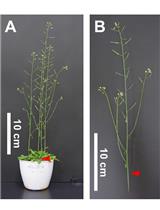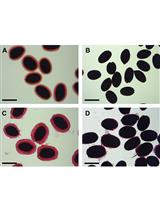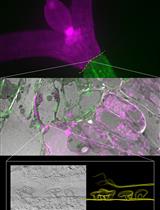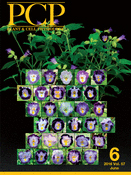- Submit a Protocol
- Receive Our Alerts
- Log in
- /
- Sign up
- My Bio Page
- Edit My Profile
- Change Password
- Log Out
- EN
- EN - English
- CN - 中文
- Protocols
- Articles and Issues
- For Authors
- About
- Become a Reviewer
- EN - English
- CN - 中文
- Home
- Protocols
- Articles and Issues
- For Authors
- About
- Become a Reviewer
Measurement of Stomatal Conductance in Rice
Published: Vol 7, Iss 8, Apr 20, 2017 DOI: 10.21769/BioProtoc.2226 Views: 13633
Reviewed by: Dennis NürnbergHideyuki TakahashiLaura Zanin

Protocol Collections
Comprehensive collections of detailed, peer-reviewed protocols focusing on specific topics
Related protocols

Tensile Testing Assay for the Measurement of Tissue Stiffness in Arabidopsis Inflorescence Stem
Kouki Yoshida [...] Nobutaka Mitsuda
Aug 5, 2019 10120 Views

Analysis of Monosaccharides from Arabidopsis Seed Mucilage and Whole Seeds Using HPAEC-PAD
Gillian H. Dean [...] George W. Haughn
Dec 20, 2019 5696 Views

Targeting Ultrastructural Events at the Graft Interface of Arabidopsis thaliana by A Correlative Light Electron Microscopy Approach
Clément Chambaud [...] Lysiane Brocard
Jan 20, 2023 2930 Views
Abstract
Stomatal conductance, the reciprocal of stomatal resistance, represents the gas exchange ability of stomata. Generally, the stomatal conductance is higher when stomata open wider, and vice versa. In this protocol, we describe how to measure stomatal conductance in rice using Li-6400 (Licor, USA).
Keywords: Stomatal conductanceBackground
Stomata consist of a pair of guard cells and open in response to blue light as a signal. Using epidermal fragments from the kidney-shaped guard cells (found mainly in dicots), the blue light-induced stomatal opening can be observed readily under a microscope. However, direct measurement of the stomatal aperture from the dumbbell-shaped guard cells in monocots, such as rice, maize, wheat, and oats, is very difficult, due to their uneven leaf surface. Thus, a gas-exchange system is useful for the measurement of blue light-induced stomatal opening in the leaves of monocots.
Materials and Reagents
- Rice (Oryza sativa) cultivar Nipponbare
Note: Rice (O. sativa) cultivar Nipponbare plants were grown at 28 °C under a photoperiod of 14 h light/10 h dark or in a greenhouse at room temperature (25-32 °C). Mature leaves, from 4-week-old plants, were used in gas-exchange measurements.
Equipment
- Portable gas-exchange system, Li-6400XT (Licor, USA), with standard chamber
Licor gas-exchange systems, especially the Li-6400 and Li-6400XT, are used widely in photosynthesis and stomatal conductance measurements. The standard chamber, as a basic accessory for the Li-6400XT, is assembled with a high-precision temperature sensor and an internal light sensor (see Figure 1). Because stomatal conductance is a function of leaf temperature (von Caemmerer and Farquhar, 1981), precise control of the leaf temperature is important. Moreover, to induce specific stomatal blue light response, an internal light sensor to measure extra red light and blue light (for the light source see below) is needed. Therefore, the standard chamber, with a high precision temperature sensor and an internal light sensor, is suitable for this experiment. - Light source
Light is provided via a fiber-optic illuminator with a halogen projector lamp (15 V/150 W; Philips, Netherlands) as the light source. A power supply (MORITEX, catalog number: MHAB-150W-100V ) was used to power the lamp. Red light (660 nm) and blue light (470 nm) are obtained with filters (#2-61 and #5-60, Corning, USA)
Procedure
- Plants are kept overnight in the dark for before gas-exchange measurements. The overnight dark-treatment lasts at least 14 h to ensure complete stomatal closure.
Note: In our case, we keep the plant in the dark in the same experiment room as the gas-exchange system. - Warm up and calibrate the Li-6400XT, following the official instruction manual https://www.licor.com/env/support/resources?p=6400XT.
- Set the control for the fixed flow model, at 500 μmol sec-1.
Important: For the standard chamber, a flow rate lower than 500 μmol sec-1 will cause insufficient gas circulation, especially when the leaf area is smaller than the chamber area (6 cm2). - Adjust the desiccant to keep the reference relative humidity (RH_R) at about 65%.
Note: In our case, a relative humidity lower than 60% will cause unstable stomatal conductance (low humidity stress). - Set the reference CO2 at ambient CO2 concentration (400 μmol mol-1) using the CO2 mixer.
- Set leaf temperature at room temperature.
Note: In our case, we set the leaf temperature at 24 °C.
Important: Do not set the ‘block temperature’ (chamber temperature) to constant instead of the ‘leaf temperature’, because even when the ‘block temperature’ is stable the leaf temperature will still fluctuate. According to the equation for stomatal conductance (see the official instruction manual for the Li-6400XT), the leaf temperature is one of the key factors for calculating stomatal conductance. A stable leaf temperature makes the stomatal conductance value representative of stomatal transpiration. - After these parameters become stable, match the system as described in the official instruction manual, then clamp the rice leaf in the center of the chamber (Figure 1B). After all the parameters have stabilized, match the system again.
Note: Make sure the lower side of the leaf touches the temperature sensor (see Figure 1).
Figure 1. How to clamp the rice leaf in the chamber and images of the illumination system. A. A picture of the standard chamber. Arrows indicate the position of the temperature sensor and the inside light sensor. B. A picture of clamping the rice leaf in the center of the chamber. Make sure the leaf surface touches the temperature sensor. C. and D. Images of the red and red + blue light illumination system. - Open a log file, name it, and add some necessary notes, such as the name of the researcher performing the measurement. Then, open Auto Program (see Figure 2), set the logging frequency (Log every_ _ secs), duration (Run for _ _ _ minutes), and match frequency (Match every _ _ _ minutes).
Note: In our case, we set those parameters as shown in Figure 2 (right panel).
Figure 2. Parameters of Auto Program. A. A picture of the content in the Auto Program. The highlight option ‘AutoLog’ is the program used in this measurement. B. A picture of the parameter settings on entering the ‘AutoLog’ program.
Note: Data in steps 9 and 10 are recorded by Auto Program.
- First measure stomatal conductance under dark condition for 30 min, and then illuminate the leaf with 700 μmol m-2 sec-1 red light from the top of the chamber, until the stomatal conductance and photosynthetic rate reach steady states (stable for at least 10 min).
Note: In our case, it always takes more than 120 min to reach the steady state. - Under the red light background, add a weak blue light (3 μmol m-2 sec-1) for 30 min and then turn the blue light off, keeping the leaf illuminated under red light for another 90 min or more. For images of red light and red + blue light illumination see Figures 1C and 1D.
- Close the Auto Program and the data log file.
- Open the chamber and measure the width of the leaf. Because the length of the chamber is 3 cm, the area of the leaf sample is equal to the leaf width x 3 cm.
- Transfer the data from equipment to computer.
- Open the data file (.xls) with Excel (Microsoft, USA). Change the default leaf area of 6 cm2 to the actual leaf area determined following step 12 (the data file is shown in Figure 3). The data sheet will recalculate the stomatal conductance and other parameters automatically with the new leaf area.

Figure 3. Example of data in Excel: changing the data for leaf area in the Excel file. The highlighted column ‘Area’ shows the default leaf area (6 cm2) that should be changed to the actual leaf area following step 12.
Data analysis
The stomatal conductance is calculated automatically by the software of the instrument. Select the ‘Obs’ column (refers to the number of objects logged in this experiment) and ‘Cond’ column (refers to the stomatal conductance), using the Chart tool to make a scatter (x, y) chart (Figure 4). Because the objects were logged every minute, the chart reflects the time course of changes in stomatal conductance.
Figure 4. Data analysis of stomatal conductance. Select the highlighted columns ‘Obs’ and ‘Cond’ to make a scatter (x, y) chart. The red arrow and blue arrows show the points when the light sources were switched on and off.
Notes
- The portable gas-exchange system, Li-6400XT, is not a simple instrument. Researchers who want to use this system for their experiments should have basic training from Licor Company (or sales agent) at first. Basic manipulations including warm-up, calibration, and match the system etc. are included in the basic training. Therefore, in this protocol we omit the details of these parts in the procedure.
- Because stomata are sensitive to light, all gas-exchange experiments should be conducted in a dim-light (less than 3 μmol photon m-2 sec-1) room or a dark room.
- This protocol is also applicable to other plant species, monocot and dicot plants, such as corn, Arabidopsis thaliana etc. For plants with irregularly shaped leaves (e.g., Arabidopsis), we recommend using a scanner or professional instrument such as the LI-3100C Area Meter (Licor, USA) to calculate the leaf area accurately.
Acknowledgments
This protocol was adapted from Toda et al. (2016). This work was supported in part by Grants-in-Aid for Scientific Research from the Ministry of Education, Culture, Sports, Science and Technology, Japan (15H05956 to T.K.), and by the Japan Science and Technology Agency [the Advanced Low Carbon Technology Research and Development Program].
References
- Toda, Y., Wang, Y., Takahashi, A., Kawai, Y., Tada, Y., Yamaji, N., Feng Ma, J., Ashikari, M. and Kinoshita, T. (2016). Oryza sativa H+-ATPase (OSA) is involved in the regulation of dumbbell-shaped guard cells of rice. Plant Cell Physiol 57(6): 1220-1230.
- von Caemmerer, S. V. and Farquhar, G. D. (1981). Some relationships between the biochemistry of photosynthesis and the gas exchange of leaves. Planta 153(4): 376-387.
Article Information
Copyright
© 2017 The Authors; exclusive licensee Bio-protocol LLC.
How to cite
Wang, Y. and Kinoshita, T. (2017). Measurement of Stomatal Conductance in Rice. Bio-protocol 7(8): e2226. DOI: 10.21769/BioProtoc.2226.
Category
Plant Science > Plant physiology > Tissue analysis
Cell Biology > Tissue analysis > Physiology
Do you have any questions about this protocol?
Post your question to gather feedback from the community. We will also invite the authors of this article to respond.
Share
Bluesky
X
Copy link









